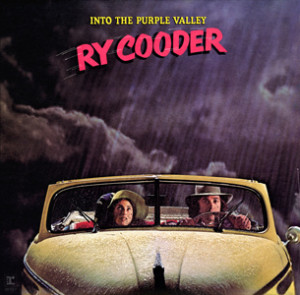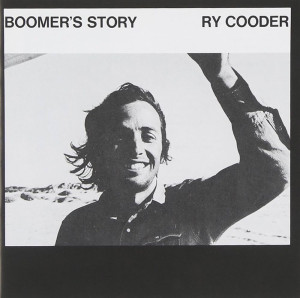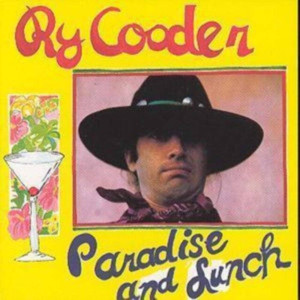Ry Cooder (Reprise, 1970)
Into The Purple Valley (Reprise, 1972)
Boomer’s Story (Reprise, 1972)
Paradise & Lunch (Reprise, 1974)
Chicken Skin Music (Reprise, 1976)
Showtime (Warner Bros., 1977)
Jazz (Warner Bros., 1978)
Bop Til You Drop (Warner Bros., 1979)
Borderline (Warner Bros., 1980)
The Slide Area (Warner Bros., 1982)
Get Rhythm (Warner Bros., 1987)
Why Don’t You Try Me Tonight: The Best of Ry Cooder (Warners Import, 1986)
River Rescue: The Very Best Of Ry Cooder (Warners Import, 1994)
Music By Ry Cooder (Warner Bros., 1995)
 In a review of Ry Cooder’s third album Boomer’s Story for Rolling Stone in 1972, Ben Gershon said this: “I wouldn’t be surprised if this [album] and the other two he has given us so far mean the same to collectors 30 years from now as the records of Ry’s antique heroes do to him today.” It has been thirty years now since Ry’s first album and his records do mean that much to us. Every day, on eBay, there are between 20 and 80 Cooder items for sale, most of which are his vinyl albums; and they all sell. They sell not because they are antiques, but because they contain some of the most potent music ever committed to vinyl. A Ry Cooder career retrospective is a daunting challenge because of the sheer volume of his work, so this article will concentrate on the thirteen albums he released between 1970 and 1987, plus some compilations and best-of’s.
In a review of Ry Cooder’s third album Boomer’s Story for Rolling Stone in 1972, Ben Gershon said this: “I wouldn’t be surprised if this [album] and the other two he has given us so far mean the same to collectors 30 years from now as the records of Ry’s antique heroes do to him today.” It has been thirty years now since Ry’s first album and his records do mean that much to us. Every day, on eBay, there are between 20 and 80 Cooder items for sale, most of which are his vinyl albums; and they all sell. They sell not because they are antiques, but because they contain some of the most potent music ever committed to vinyl. A Ry Cooder career retrospective is a daunting challenge because of the sheer volume of his work, so this article will concentrate on the thirteen albums he released between 1970 and 1987, plus some compilations and best-of’s.
Born in 1947 in Los Angeles, California, Cooder essentially began playing the guitar when he was laid up in bed, recuperating from a childhood accident that cost him an eye when he was 4. He focused on mastering the instrument throughout his childhood and eventually quit high school when he discovered he was making far more money playing sessions than his teachers were being paid. In 1966 he formed the Rising Sons with Taj Mahal and Ed Cassidy (later of Spirit), but their album of skillfully blended blues, folk and rock was not issued until 1989! After a quick stop in Captain Beefheart’s Magic Band, where he set the guitar sound for future Magic Bands with his remarkable slide work on Safe As Milk, Cooder continued to add his trademark sound to sessions for Randy Newman, Paul Revere & the Raiders, and the Rolling Stones. An early attempt at a soundtrack for the film “Candy” was shelved and then reworked for the Mick Jagger vehicle Performance (1969). The sound was revelatory, and leaped out of theater speakers all over the world, announcing “Ry Cooder Is Here!”
His first solo album appeared in 1970. The front cover of this self-titled LP showed a portrait of Ry standing in front of a classic Airstream trailer parked in a desert. The music was just as esoteric. It ranged from the Depression-era folk of Woody Guthrie’s “DoReMi” and Alfred Reed’s “How Can A Poor Man Stand Such Times And Live” to blues from Blind Blake and Sleepy John Estes. The strange “Pigmeat” sounds like a New Orleans jazz band on acid. Probably the most important song on this first album is the closer, a deeply moving, moody version of Blind Willie Johnson’s “Dark Is The Night.” This would become a career theme song, reworked and adapted as the theme for the Wim Wenders film Paris, Texas. For many fans, this remains a favorite album.
Into the Purple Valley followed in 1972, and then later the same year Boomer’s Story. Jim Dickinson and Lenny Waronker produced them, and Ry gathered a new band of top-flight musicians for these new collections of classics. In particular, In the Purple Valley introduced the Bahamian guitar master Joseph Spence. Spence’s loose, syncopated picking deeply influenced Cooder’s style, as it did almost every other guitarist who has heard him.
Johnny Cash’s “Hey Porter” is slowed down and presented with mandolin accompaniment (the mandolin is Cooder’s second instrument and equally  important in forming his trademark sound). Song selection is extraordinary on all Cooder albums. This is how he got the reputation for being a musical archivist (a title he hates because it makes him sound like a museum curator), but it is the arrangements on these old songs that sets him apart. Rather than try to recreate the old sound (like Mike Seeger’s New Lost City Ramblers), Ry chooses a rocking framework and drops seemingly unrelated material into it. So the steel-band tune “FDR in Trinidad” becomes a finger-picking workout, or the western ballad “Billy the Kid” becomes a mandolin blues.
important in forming his trademark sound). Song selection is extraordinary on all Cooder albums. This is how he got the reputation for being a musical archivist (a title he hates because it makes him sound like a museum curator), but it is the arrangements on these old songs that sets him apart. Rather than try to recreate the old sound (like Mike Seeger’s New Lost City Ramblers), Ry chooses a rocking framework and drops seemingly unrelated material into it. So the steel-band tune “FDR in Trinidad” becomes a finger-picking workout, or the western ballad “Billy the Kid” becomes a mandolin blues.
Boomer’s Story builds on the sounds of the previous records. Rather than covering another Sleepy John Estes track, Cooder plays back-up to Sleepy John on a version of “President Kennedy,” a sombre tribute to the slain leader. Cooder plays mandolin, taking the place of Estes’ regular partner Hammie Nixon. He captures the campfire glow of the Civil War with “Rally Round the Flag”; he claims ownership of “Maria Elena” from Los Indios Tabajares; and he haunts us again with his instrumental version of Dan Penn’s classic “Dark End of the Street.”
It is Ry’s arrangements, his unique merging of musical styles, and his choice in back-up musicians that make him special to his fans. With 1974’s Paradise & Lunch he introduced the gospel quartet-style singing of the Swan Silvertones, et al., into the mix. Ry continued to trawl the old records for Washington Phillipps’ “The Tattler,” which he does in a version so different from the original that he was able to take a co-writing credit. He even managed to work his magic on a Burt Bacharach song, “Mexican Divorce.” “Down around El Paso lies Juarez / Mexico is different so the travel folder says…” The music backing these lyrics paints a picture of just how different Mexico can be!
It was the Bacharach track that led Hawaiian slack-key legend Gabby Pahinui to accept Ry as an equal. “This is chicken skin music!” Gabby told his associates, using a local expression akin to “goose bumps.” So, Ry called his next LP Chicken Skin Music and travelled to Hawaii to record some of it. Hank Snow’s gem “Yellow Roses” is done as a country song with Gabby’s mellifluous steel guitar floating through its core. If you aren’t touched by this, you must be dead. The jazzy instrumental “Chloe” also features Gabby’s steel alongside Ry’s acoustic guitar; both are jaw-droppingly good. Much of the rest of the album introduces Ry’s interest in Norteño music and features accordionist Flaco Jimenez. Listen to “Goodnight Irene,” played as a last waltz!
Flaco and his band became Ry’s touring core, and provided the basis for his next album, 1977’s Showtime. Recorded at San Francisco’s Great American Music Hall (except for the opener, “School’s Out,” presented in a rollicking TexMex studio version), this is an excellent live album, which is at this writing unfortunately out of print (except for expensive import versions). The album offers a quick review of Cooder’s career to date, starting with “Alimony” from the first album, through “DoReMi,” “Dark End of the Street” (with gospel trio vocals this time!), and “How Can A Poor Man,” all arranged for the Norteño sounds of the new band. The live format gives Ry a chance to open up on guitar, and his solos are stunning.
The following year 1978 found Ry experimenting with a kind of cafe jazz and vaudeville for an album called Jazz. Arranged and produced by Joseph  Byrd, this music is definitely not jazz, but it is something. It features the compositions of troubled cornetist Bix Beiderbecke, along with songs by Jelly Roll Morton and Bert Williams. Joseph Spence gets a “Salvation Army Band” approach for his “Happy Meeting In Glory.” This album was featured on a PBS broadcast entitled In A Mist (after one of the Beiderbecke tunes). Cooder has since virtually disowned this record, but it has some great playing and remains a fan favorite.
Byrd, this music is definitely not jazz, but it is something. It features the compositions of troubled cornetist Bix Beiderbecke, along with songs by Jelly Roll Morton and Bert Williams. Joseph Spence gets a “Salvation Army Band” approach for his “Happy Meeting In Glory.” This album was featured on a PBS broadcast entitled In A Mist (after one of the Beiderbecke tunes). Cooder has since virtually disowned this record, but it has some great playing and remains a fan favorite.
Bop Til You Drop was the world’s first digitally recorded popular album. Released in 1979, this is a potent collection of ’50s rock’n’roll. Cooder has spoken out against the digital techniques used to record Bop for their sonic limitations, but this album sounds tremendous to these ears. This record features a crackerjack band led by Jim Keltner and Milt Holland on drums, Tim Drummond on bass, David Lindley (Ry’s perfect foil) on guitars, and the extraordinary singing of Bobby King and Terry Evans.
In 1980 Ry released a follow-up, the steaming Borderline. At a concert where he played most of the songs from these two albums and featured band-mates Keltner, Evans and King, as well as new amigo John Hiatt, a woman sitting in front of me declared, “If he sings one more song about cars or girls, I’m leaving!” Then Ry kicked into “Crazy ’bout an Automobile” and away she went! Her husband watched her leave as Ry sang, “Every woman I know, Crazy ’bout an automobile, and here I am standing with nothin’ but rubber heels!” then he shrugged his shoulders, gazed longingly at the stage and followed his wife out to the parking lot for what I assume was a loonnngg ride home. Too bad; the rest of the show, like these records, cooked!
The Slide Area was released in 1982 and was more of the same, but with a noticeable difference. Ry’s guitar playing was sterling, the band was hot, the rhythms solid, and the vocalists great, but that was somehow not enough. The songs were the key to the success of a Ry Cooder album, and Bob Dylan castoffs (“I Need A Woman”) and recycled riffs just didn’t do it. The fans were at last disappointed by a Ry Cooder record! It would be a long wait before they’d get another one. Maybe Ry had run out of gas. Maybe he was just tired of doing it over and over. He said in interviews that the strange angular music he was making on movie soundtracks was far more satisfying than what he’d been able to do on his solo albums. He was looking for new challenges. He began scoring movies on a regular basis. Paris, Texas, The Long Riders, Southern Comfort, Trespass, Geronimo and others, all had moods created by mixing his growling, snaking slide guitar with samples and beats by Jim Keltner, and perhaps adding a muted trumpet, or a shakuhachi. The Hollywood money poured in.
In 1987 Ry Cooder released his last solo album to date. Get Rhythm was a much stronger collection than The Slide Area. It reflected his new interest in the music of Okinawa (he had earlier recorded with Okinawan superstar Shoukichi Kina) and mixed it with old rock’n’roll and his trademark sounds. It was a good sign, a return to form, but it is the last album of this type he has given us. His fans pray for another one like this.
Since then, two Cooder collections have been issued. England’s Why Don’t You Try Me Tonight (1986) and in Europe River Rescue: the Very Best of Ry Cooder (1994) are both solid collections with the only unreleased cut being the title track of River Rescue.”
There have been rumors of a box set which has not come to fruition. In fact, Ry’s interest in his old recordings is not very high. He is always looking at the next project. This month (June 2000) he was awarded an honorary doctorate at Queen’s University (Kingston, Ontario, Canada) where he told the graduates to “put yourself into some situation that you can’t predict … and see if you can make it work … and maybe you’ll get lucky and some 90-year-old person will come along who can really show you a thing or two.” This is the road he has chosen for himself. He is currently finishing up a project recording with an old, blind, Vietnamese street musician. He has scored almost 30 films. (See Music by Ry Cooder, Warner Bros., 1995, a collection of his best film music.) He also continued his experiments in the field of world music, recording with the Hawaiians again, with Indian guitarist V. M. Bhatt (for a Grammy), with Malian singer-guitarist Ali Farka Toure (for a Grammy); and in 1997 he began an ongoing project with Cuban musicians which led to a series of successful CDs, a movie and a book all under the title Buena Vista Social Club.
The Ry Cooder Quarterly (The Rylander), which I publish, is in its third year and has subscribers around the world. The main thing that people talk to me about is the sound: Ry’s mandolin and his guitar. The unmistakable funky feel of his music. Visit the Ry Cooder Web site and take up the challenge webmaster Neil MacKinnon offered when he named the site…”Why Don’t You Try Ry?”
[Update: David went on to review Ry’s The UFO Has Landed: The Ry Cooder Anthology, and Ry Cooder & Manuel Galban’s Mambo Sinuendo. He published The Rylander blog until 2013. Ry Cooder continues to perform and record (including several solo albums of critical and popular acclaim; learn more at his website.]
